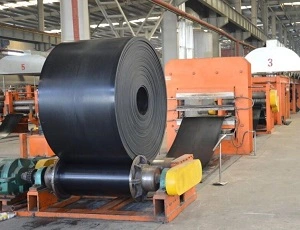Tel: +86-532-84673097
Mobile & Whatsapp & Wechat:+86-13589340409
Mobile & Whatsapp & Wechat:+86-13589340409
Conveyor belts serve as the primary tools for transporting coal in underground mines. Currently, the conveyor belts used in underground coal mines are primarily flame-resistant and anti-static. Two main types of these belts exist: fabric core flame-resistant conveyor belts and steel cord flame-resistant conveyor belts.

Advantages: Flame-resistant, anti-static, waterproof, tear-resistant, thin belt body, lightweight, low energy consumption, relatively simple production process.
Disadvantages: Substantial elongation, shorter lifespan (typically not exceeding 4 years), limited cumulative coal transportation (not exceeding 5 million tons).
Advantages: Flame-resistant, anti-static, high tensile strength, excellent impact resistance, minimal elongation, good troughing performance, excellent resistance to bending fatigue, long lifespan (generally 5 to 10 years).
Disadvantages: Thick belt body, higher weight, higher tear resistance, higher energy consumption during transportation, complex production process.
In a coal mining area with a downhill transportation requirement, where the throughput (Q) is 1500t/h, horizontal distance (L) is 2025m, and vertical lift (H) is 40m, selecting the appropriate conveyor belt is crucial. Despite fabric core belts being lighter under the same tensile strength conditions, considering safety factors, the steel cord conveyor belt is often the preferred choice. This preference arises from the fact that fabric core belts require a higher safety factor, leading to a need for a larger belt strength under the same material lifting conditions.
The tensioning of conveyor belts should be determined based on factors like the length of the conveyor, start and stop methods, and belt characteristics. The calculation for tensioning travel (Lsp) is given by the formula: Lsp ≥ (ε0 + ε1) L + LN.
Fabric Core Flame-Resistant Conveyor Belt: Lsp ≥ (ε0 + ε1) L + LN = (0.015 + 0.001) × 2025 + 2 = 34.4m
Steel Cord Flame-Resistant Conveyor Belt: Lsp ≥ (ε0 + ε1) L + LN = (0.0025 + 0.001) × 2025 + 1.55 = 8.6m
For underground belt conveyors, the steel cord belt allows for straightforward tensioning, while the fabric core belt requires a hydraulic cylinder + winch tensioning method due to its longer tensioning travel.
Both fabric core and steel cord flame-resistant conveyor belts are suitable for underground belt conveyors in coal mines.
For short distances and lower throughputs, fabric core belts may be preferred. However, for longer distances and higher throughputs, a careful calculation is necessary. When the difference in belt weight is not significant, the steel cord belt is often the better choice, offering a lifespan approximately 3 to 5 times longer than that of fabric core belts.
Different tensioning methods are required for fabric core and steel cord belts due to their varying elongation coefficients. The choice of conveyor belt and tensioning method should be carefully considered based on specific mining conditions and requirements.